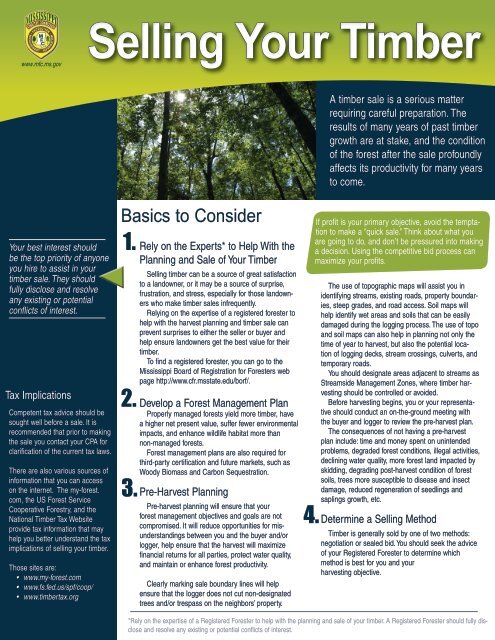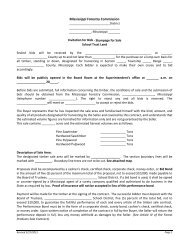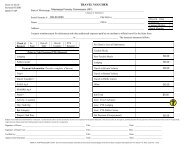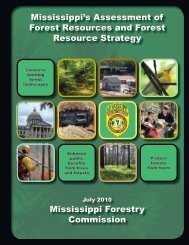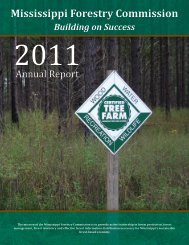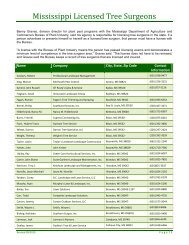Selling Your Timber
Timber Sale Brochure - Mississippi Forestry Commission - ms.gov
Timber Sale Brochure - Mississippi Forestry Commission - ms.gov
- No tags were found...
Create successful ePaper yourself
Turn your PDF publications into a flip-book with our unique Google optimized e-Paper software.
www.mfc.ms.gov<br />
<strong>Selling</strong> <strong>Your</strong> <strong>Timber</strong><br />
<strong>Your</strong> best interest should<br />
be the top priority of anyone<br />
you hire to assist in your<br />
timber sale. They should<br />
fully disclose and resolve<br />
any existing or potential<br />
conflicts of interest.<br />
Tax Implications<br />
Competent tax advice should be<br />
sought well before a sale. It is<br />
recommended that prior to making<br />
the sale you contact your CPA for<br />
clarification of the current tax laws.<br />
There are also various sources of<br />
information that you can access<br />
on the internet. The my-forest.<br />
com, the US Forest Service<br />
Cooperative Forestry, and the<br />
National <strong>Timber</strong> Tax Website<br />
provide tax information that may<br />
help you better understand the tax<br />
implications of selling your timber.<br />
Those sites are:<br />
• www.my-forest.com<br />
• www.fs.fed.us/spf/coop/<br />
• www.timbertax.org<br />
Basics to Consider<br />
1.<br />
2.<br />
3.<br />
Rely on the Experts* to Help With the<br />
Planning and Sale of <strong>Your</strong> <strong>Timber</strong><br />
<strong>Selling</strong> timber can be a source of great satisfaction<br />
to a landowner, or it may be a source of surprise,<br />
frustration, and stress, especially for those landowners<br />
who make timber sales infrequently.<br />
Relying on the expertise of a registered forester to<br />
help with the harvest planning and timber sale can<br />
prevent surprises to either the seller or buyer and<br />
help ensure landowners get the best value for their<br />
timber.<br />
To find a registered forester, you can go to the<br />
Mississippi Board of Registration for Foresters web<br />
page http://www.cfr.msstate.edu/borf/.<br />
Develop a Forest Management Plan<br />
Properly managed forests yield more timber, have<br />
a higher net present value, suffer fewer environmental<br />
impacts, and enhance wildlife habitat more than<br />
non-managed forests.<br />
Forest management plans are also required for<br />
third-party certification and future markets, such as<br />
Woody Biomass and Carbon Sequestration.<br />
Pre-Harvest Planning<br />
Pre-harvest planning will ensure that your<br />
forest management objectives and goals are not<br />
compromised. It will reduce opportunities for misunderstandings<br />
between you and the buyer and/or<br />
logger, help ensure that the harvest will maximize<br />
financial returns for all parties, protect water quality,<br />
and maintain or enhance forest productivity.<br />
Clearly marking sale boundary lines will help<br />
ensure that the logger does not cut non-designated<br />
trees and/or trespass on the neighbors’ property.<br />
4.<br />
A timber sale is a serious matter<br />
requiring careful preparation. The<br />
results of many years of past timber<br />
growth are at stake, and the condition<br />
of the forest after the sale profoundly<br />
affects its productivity for many years<br />
to come.<br />
If profit is your primary objective, avoid the temptation<br />
to make a “quick sale.” Think about what you<br />
are going to do, and don’t be pressured into making<br />
a decision. Using the competitive bid process can<br />
maximize your profits.<br />
The use of topographic maps will assist you in<br />
identifying streams, existing roads, property boundaries,<br />
steep grades, and road access. Soil maps will<br />
help identify wet areas and soils that can be easily<br />
damaged during the logging process. The use of topo<br />
and soil maps can also help in planning not only the<br />
time of year to harvest, but also the potential location<br />
of logging decks, stream crossings, culverts, and<br />
temporary roads.<br />
You should designate areas adjacent to streams as<br />
Streamside Management Zones, where timber harvesting<br />
should be controlled or avoided.<br />
Before harvesting begins, you or your representative<br />
should conduct an on-the-ground meeting with<br />
the buyer and logger to review the pre-harvest plan.<br />
The consequences of not having a pre-harvest<br />
plan include: time and money spent on unintended<br />
problems, degraded forest conditions, illegal activities,<br />
declining water quality, more forest land impacted by<br />
skidding, degrading post-harvest condition of forest<br />
soils, trees more susceptible to disease and insect<br />
damage, reduced regeneration of seedlings and<br />
saplings growth, etc.<br />
Determine a <strong>Selling</strong> Method<br />
<strong>Timber</strong> is generally sold by one of two methods:<br />
negotiation or sealed bid. You should seek the advice<br />
of your Registered Forester to determine which<br />
method is best for you and your<br />
harvesting objective.<br />
*Rely on the expertise of a Registered Forester to help with the planning and sale of your timber. A Registered Forester should fully disclose<br />
and resolve any existing or potential conflicts of interest.
Properly managed<br />
forests yield more timber,<br />
have a higher net<br />
present value, suffer<br />
fewer environmental<br />
impacts, and enhance<br />
wildlife habitat more than<br />
non-managed forests.<br />
You should always<br />
consult with a registered<br />
forester and attorney<br />
when drafting a timber<br />
sale contract.<br />
Whether you’re dealing<br />
directly or indirectly with<br />
a timber buyer, wood<br />
supplier, logger, registered<br />
forester or consultant, you<br />
should always request<br />
references, experience,<br />
applicable licenses, and<br />
certifications.<br />
5.<br />
• Negotiated sales involve face-to-face bargaining<br />
between you and the buyer.<br />
• Sealed bid sales require that prospective buyers<br />
submit confidential offers in writing for your timber.<br />
Generally, the sealed bid method returns the highest<br />
dollar value to you, the landowner, especially if you<br />
are unfamiliar with local markets. The negotiated sale<br />
is more prevalent for specialty products such as highvalue<br />
hardwoods, where there are normally very few<br />
bidders. Whichever sale method is selected, you should<br />
require the logger to be Professional Logging Manager<br />
(PLM) certified.<br />
A trained professional logger can ensure trees are<br />
effectively harvested and merchandised in a manner<br />
that fully utilizes Best Management Practices (BMPs).<br />
This is particularly important as more emphasis is<br />
being placed on protecting and enhancing water quality.<br />
It’s a good idea to take time to know the prospective<br />
logger by asking for references, business experience,<br />
and whether they have completed PLM training. You<br />
or your agent can verify they’ve attended Mississippi’s<br />
PLM course by going to the Professional Logging<br />
Manager’s website at www.loggered.msstate.edu/<br />
(If you choose to sell your timber through the bid process,<br />
you may limit your ability to specify a particular logger.)<br />
Have a Contract<br />
A written contract is essential and will reduce<br />
surprises to both you and the buyer and/or logger.<br />
Preparing a contract encourages forethought and planning,<br />
which will minimize difficulties and ensure that the<br />
transaction meets your expectations. A contract is not a<br />
substitute for good faith and fair dealing between parties,<br />
it is a framework in which good faith and fair dealing<br />
can operate in an orderly and effective manner.<br />
The following items should be included in a timber<br />
sale contract:<br />
<strong>Timber</strong> Description<br />
• An Accurate Legal Description:<br />
In the contract, state the exact location and legal<br />
description of the timber sale area.<br />
• Marking Corners and Boundaries:<br />
The contract should state at whose expense<br />
marking will be done and how the boundaries and<br />
Preparing a contract<br />
encourages forethought<br />
and planning, which will<br />
minimize difficulties and<br />
ensure that the transaction<br />
meets your expectations.<br />
corners will be marked.<br />
• <strong>Selling</strong> <strong>Timber</strong> on a Per-Unit Basis:<br />
If you choose to sell timber by the unit, specify the<br />
units of measurement to be used, who is to do<br />
the measuring, and where. Measurements may<br />
be made by one of several different methods: log<br />
scales, weight, cords, or some combination of<br />
these. A per-unit sale should specify that all timber<br />
harvested is to be measured and paid for according<br />
to its most valuable product use.<br />
• The Type of Harvest:<br />
Specify the type of harvest you desire and if the<br />
timber is marked, how it’s marked. For example, if<br />
you are making a seed tree cut, you may specify<br />
that all trees banded with blue paint 4-1/2 feet<br />
above ground (Diameter at Breast Height, DBH)<br />
are seed trees and will not be cut or damaged. If<br />
you are thinning or using a select cut, you may<br />
want to designate the trees to be cut with one<br />
paint spot above DBH and another below the<br />
stump height. If you are doing an operator-select<br />
harvest, specify selection guidelines in the contract.<br />
Payment, Damage Clauses, and Penalties<br />
The following are provisions to consider including in<br />
a timber sale contract. Be aware that some restrictions<br />
placed on harvesting may lower the price someone is<br />
willing to pay for your timber, so be reasonable in your<br />
expectations.<br />
• <strong>Selling</strong> <strong>Timber</strong> on a Lump-Sum Basis:<br />
If you are selling your timber on a lump-sum basis,<br />
specify that you desire payment in full at the time<br />
of contract execution; or if you are deferring payment,<br />
the exact date(s) you expect payment.<br />
(A lump-sum sale is the outright sale of standing<br />
timber for a fixed dollar amount agreed upon in<br />
advance. The sale price is not a function of the<br />
volume cut.)<br />
• <strong>Selling</strong> <strong>Timber</strong> on a Per-Unit Basis (price):<br />
If you are selling on a per-unit basis, specify the<br />
payment per unit for each species and product,<br />
as well as timing of payments. Additionally, agree<br />
on the method and place of scaling and measurement.<br />
Also, you should require in the contract that<br />
the buyer provide you with a complete accounting<br />
of all species and products by delivery point that
As important as it is, the<br />
contract is only one of many<br />
issues that needs to be<br />
considered when the decision<br />
to sell timber is being made.<br />
The following concerns should<br />
have a bearing on the content<br />
within the contract:<br />
are harvested from your sale.<br />
(A per-unit price is determined in advance, but the amount<br />
of timber to be harvested is not. Income from sale is based<br />
strictly on the volume actually harvested.)<br />
• Time Period for Cutting <strong>Timber</strong>:<br />
Normal time periods for cutting timber are 12 to 24<br />
months. There can be provisions for extensions, but<br />
the details and timing of the extension should be<br />
defined. There is usually a cost to the buyer for an<br />
extension, and you can consider the value of additional<br />
growth if the buyer holds for longer than 12 months.<br />
• Damage to <strong>Your</strong> Land or Remaining <strong>Timber</strong>:<br />
A certain degree of damage should be expected. You<br />
may want to visit a comparable site that has been<br />
recently harvested by the logger who will harvest<br />
your tract. Also, you may want to state your damage<br />
requirements, such as no more than a maximum number<br />
of trees per acre having visible skidding damage,<br />
or specify the acceptable depth (in inches) of skidding<br />
ruts.<br />
• Access Restrictions:<br />
Specify any restrictions you have for ingress and<br />
egress to your property. For example, If you desire that<br />
the logger not use a certain entrance to your property,<br />
such as through your pasture or beside your house,<br />
specify this requirement in the contract.<br />
• If You are Making a Partial Cut:<br />
Include a penalty for cutting non-designated trees.<br />
If you specify in the contract a dollar value per merchantable<br />
tree volume for the cutting of non-designated<br />
trees, later problems will be more easily resolved.<br />
The usual penalty for such damage is double or triple<br />
the stumpage rate.<br />
• Removing Canopy or Overstory:<br />
If you intend to remove a canopy or overstory to allow<br />
the future stand room to grow, you should likewise<br />
specify a penalty for failure to cut designated trees.<br />
• Logging Notification:<br />
Agree on when logging can begin and ask to be<br />
notified prior to the logger moving on the sale site.<br />
Logging Clauses<br />
• Method of Logging:<br />
You may specify a certain method of logging be used,<br />
such as a forwarding system instead of tree-length<br />
skidding, to minimize damage to your residual stand<br />
during a thinning operation.<br />
• Road Maintenance and Skid Trail Layout:<br />
If you desire that roads be maintained to a minimum<br />
standard, refer to that standard in the contract. A<br />
usual requirement is to return roads to as good or<br />
better condition than before logging occurred. Address<br />
your expectations for repair of fences or other special<br />
places that may be damaged during the harvesting<br />
operation.<br />
1. Do you have a clear title for<br />
the timber being sold?<br />
2. Have you established your<br />
tax basis for the land and<br />
timber you plan to sell to<br />
claim your capital gains<br />
treatment?<br />
3. What are the market conditions<br />
for the products being<br />
sold or retained?<br />
4. How will the sale be<br />
marketed to receive the<br />
best price or the best job?<br />
5. Will there be any environmental<br />
issues (i.e. wetland<br />
management or threatened<br />
& endangered species)<br />
involved in the sale area?<br />
6. How will the sale area be<br />
accessed? You would not<br />
want large equipment<br />
utilizing trails or traveling<br />
on property outside the<br />
sale area.<br />
7. Site preparation and<br />
reforestation options.<br />
These topics are not all inclusive<br />
but show why pre-harvest<br />
planning is important.<br />
<strong>Timber</strong> Sale Timeline<br />
Develop a Forest<br />
Management Plan<br />
Monitor Harvest<br />
Hire a<br />
Registered Forester<br />
Develop Harvesting Schedule<br />
- Decide to Have a Sale<br />
- Determine Type of Harvest<br />
- Check <strong>Timber</strong> Prices<br />
- Delineate Sale Boundary<br />
- Identify Special Requirements<br />
Pre-Harvest Planning<br />
Closeout with<br />
- Develop Prospectus<br />
Buyer/Logger<br />
- Select <strong>Timber</strong> Buyer/Logger<br />
- Develop Harvest Plan<br />
- Contract<br />
- Pre-Harvest Conference with Buyer/Logger
Monitor<br />
the Harvest<br />
Operation<br />
Check the logging operation on a<br />
regular basis to ensure contract<br />
requirements are being met.<br />
Always require as part of pay-perunit<br />
sales that you are provided<br />
with a full accounting of what’s<br />
being harvested. This information<br />
should be provided to you by the<br />
buyer. The frequency with which<br />
you receive this information is up<br />
to you, but it’s recommended that<br />
it be provided on a regular time<br />
schedule, i.e. weekly, monthly, etc.<br />
Requiring a load-by-load accounting<br />
of forest products removed<br />
from your timber sale is a good<br />
business practice for you and the<br />
buyer. It provides you with a full<br />
accounting of what is harvested<br />
off your property and helps<br />
ensure that contractual terms are<br />
fulfilled.<br />
Record-keeping on per-unit sales:<br />
• Load number<br />
• County and state of origin<br />
• Landowner’s name<br />
• Date and time<br />
• Scale ticket number<br />
• Species and product<br />
• Destination<br />
• Purchaser<br />
Acknowledgements:<br />
• Dr. Richard Brinker<br />
• Auburn University<br />
• Alabama Cooperative<br />
Extension System<br />
• Arkansas Forestry<br />
Commission<br />
• North Carolina Department of<br />
Forest Resources<br />
• Cornell Cooperative Extension<br />
• Steve Nix, About.com Guide<br />
• USDA Forest Service,<br />
Cooperative Forestry<br />
• Reduce the possibilities for non-point source<br />
pollution:<br />
You should specify that all logging should be done<br />
in accordance with “Mississippi’s Best Management<br />
Practices (BMPs) for Forestry.” For more information<br />
on BMPs visit our website at www.mfc.ms.gov/waterquality.php<br />
• Stump Height and Top Diameter Harvested:<br />
If stump height and top diameter harvested is<br />
important to you, then you should specify, in inches, the<br />
maximum stump height allowed or top diameter. If you<br />
want to easily machine-plant your next timber stand,<br />
allow a maximum stump height over which the tree<br />
planter can easily maneuver.<br />
• <strong>Selling</strong> <strong>Your</strong> <strong>Timber</strong> Based on Unit Volume:<br />
If you are selling your timber based on unit volume, be<br />
sure to specify the maximum top diameter that you will<br />
allow to remain in the woods.<br />
• Cleanup:<br />
Include a statement requiring removal of all litter and<br />
trash from the logging operation. You may also want to<br />
specify that logging debris be scattered back over the<br />
site, versus piled at the logging deck.<br />
The Sale and Harvest<br />
• Arrange a meeting with the buyer and/or logger so that<br />
you or your representative can point out any<br />
special restrictions that you have imposed. Walk the<br />
sale site to ensure sale boundary lines and other<br />
restrictions are understood.<br />
• Check the logging operation on a regular basis and<br />
inform the logging supervisor if you think that the terms<br />
of the contract are not being faithfully followed.<br />
• Be reasonable in your expectations and assignment of<br />
damage penalties. In some instances, the amount<br />
that you receive for your timber may be reduced<br />
due to excessive restrictions.<br />
Other Contract Provisions to Consider<br />
• Name and address of buyer<br />
• Date contract is executed<br />
• Declarations of the seller’s ownership and right<br />
to convey. This may include a title abstract and<br />
insurance.<br />
• Clarify ownership of by-products.<br />
• Liability Insurance of all contractors and<br />
sub-contractors<br />
• State who is responsible for paying severance tax.<br />
• Statement of who suffers the loss if timber is destroyed<br />
or stolen<br />
• Provision for or against assignment of the contract<br />
• Notarization of the contract<br />
www.mfc.ms.gov<br />
6.<br />
7.<br />
• Recording of the contract at the county courthouse<br />
• A performance bond or deposit — collected from the<br />
buyer prior to the commencement of harvesting — to<br />
be held by a third party until provisions of the contract<br />
are met<br />
• Require PLM certification for logger.<br />
Monitor the Harvest<br />
You or your agent should frequently inspect the<br />
harvesting operation to ensure the contract terms are<br />
being fulfilled.<br />
When you sell on a per-unit basis, a full accounting of<br />
what was removed during the harvest should be provided<br />
by the buyer. You can designate how frequently you want<br />
the information: weekly, monthly, or at the end of the sale.<br />
Minimum information received should include:<br />
• Each load of timber leaving a cutting site must be<br />
assigned a load number. Load numbers for each job<br />
site should be in numerical sequence.<br />
• The county and state where the timber was cut<br />
• The landowner’s name, or if multiple owners, the name<br />
of the estate where the timber is being cut.<br />
• Date and time the forest product was loaded on the<br />
truck<br />
• The scale ticket number that corresponds to each<br />
load number to verify delivery of individual loads of<br />
forest product<br />
• The forest product type identified (for example: pine<br />
logs, pine poles, pine pulpwood, hardwood logs,<br />
hardwood pulp, chip and saw, woody biomass, and<br />
miscellaneous forest products)<br />
• Destination of the first wood-receiving facility that the<br />
forest product is being transported to<br />
• The name of the logging company, wood dealer, or<br />
producer removing the forest products<br />
Closeout with Buyer/Logger<br />
• A notice of completion of harvest from the buyer can be<br />
helpful in removing any question if the buyer considers<br />
the harvest complete and relinquishes remaining<br />
biomass back to owner.<br />
• Review and agree on action and timing to address<br />
any land or timber damages related to harvesting<br />
operations.<br />
• Address any other issues related to non-compliance<br />
of the contract.<br />
• Ensure compliance with BMPs.<br />
For more information, contact one of the following agencies or organizations:<br />
www.fs.fed.us<br />
www.msforestry.net<br />
http://www.msforestry.net/treefarm/<br />
the-farm-program.html<br />
http://www.msforestrystry.net/sfiloggers/<br />
sustainable-forestry-initiative.html<br />
www.msucares.com<br />
The Mississippi Forestry Commission (MFC) provides equal employment opportunity and services to all individuals regardless of disability, race, age, religion, color, gender, creed, national origin, or<br />
political affiliation. This institution is an equal opportunity provider.


